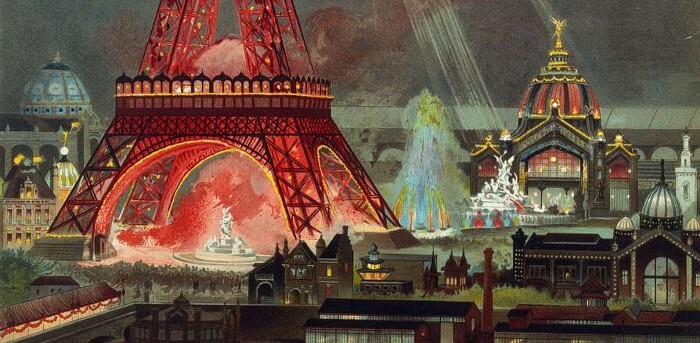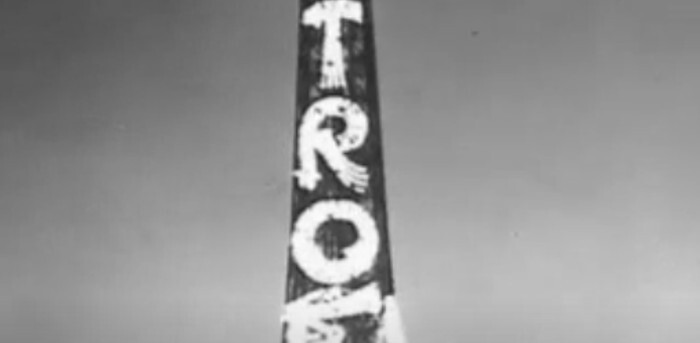The Eiffel Tower: 15 Bonkers Facts About the Iron Lady

The Eiffel Tower is one of the most visited landmarks in the world, so naturally, a lot of people have been stupid there. They’ve also been ingenious, physically strange, and very occasional, sexually aroused. For whatever reason, the Iron Lady really brings out the full spectrum of human and inorganic weirdness.
This Eiffel Guy

The engineer who designed the Eiffel Tower and lent it his name, Gustave Eiffel, had a redemption arc worthy of Hollywood. He was at the top of his game after designing the support structure of the Statue of Liberty, but it all came crashing down (not literally, thankfully) with the Panama Canal scandal, which wasn’t even his fault but still netted him a prison sentence of two years before he was ultimately acquitted. With his reputation in shambles, he vowed to build a tower so Eiffel that no one would besmirch the name again.
It Was Red

When it first opened to the public on March 31, 1889, the Eiffel Tower was a saucy reddish-brown color. When that faded, they painted it yellow, then what that faded, they developed its own color called “Eiffel Tower Brown” that you can buy yourself at Home Depot or whatever. It’s kind of ugly when it’s not on a breathtaking achievement in architecture, but you do you.
It’s an Optical Illusion
Technically, the tower is painted three different shades of brown, with the darkest at the bottom and lightest at the top. That way, when viewed from the ground, it looks all the same color.
It Changes Size
Thermal expansion causes the tower to grow in the summer up to six inches higher than its winter height. Think of it as a metallic boner. The top of the tower also leans away from the sun like a giant sunflower and sways in the wind, so if you needed a reason to avoid the lines, there you go.
Everyone Hated It
It’s an international symbol of beauty and romance now, but while it was built, the artists and intellectuals of France spent most of their non-arting and -intellectualizing time being mad at what they called a “useless and monstrous” “ink stain” on the Parisian landscape that they compared to a “gigantic black factory chimney.” The French literary community held a veritable insult contest, calling the tower “this truly tragic street lamp,” “this belfry skeleton,” “this mast of iron gymnasium apparatus, incomplete, confused and deformed,” “this high and skinny pyramid of iron ladders, this giant ungainly skeleton,” and “this hideous column with railings, this infundibuliform chicken wire, glory to the wire and the slab, arrow of Notre-Dame of bric-a-brac.” Not concise people, the 19th-century French.
It Hosted the World’s Largest Advertisement

Those people must have been especially angry when, from 1925 to 1934, the tower served as a giant billboard for Citroën cars. According to the Guiness Book of World Records, it was the world’s largest advertisement at the time.
There’s a Whole Economy Up There

It’s got restaurants, a skating rink, the preserved apartment and lab of Gustave Eiffel, a post office you can send stuff from just to say you did, a military bunker, and of course, a champagne bar, because it’s not a French tourist attraction if you’re not getting bubble drunk.
Tons of People Have Died There

Tragically but predictably for the highest structure in the world at one time, the Eiffel Tower was the site of about a suicide a month (349 total) until they increased their anti-suicide barriers in 1966. It’s also attracted daredevils, including a would-be parachutist who fell to his death in 1912, another who followed in his footsteps in 2005, and a pilot who made (and lost) a bet that he could fly underneath the tower in 1926.
Catching Mata Hari

The tower isn’t just pretty. It’s got antennae and stuff, which were used during World War I by the French military to intercept messages from Germany, including one that they unscrambled to identify Mata Hari.
Hitler’s Revenge

(National Archives and Records Administration/Wikimedia Commons)
Legend has it that when German forces took Paris in 1940, French resistance fighters cut the cables to the Eiffel Tower’s elevators so Hitler would be forced to take the stairs if he wanted to get to the top. Four years later, he ordered the tower destroyed, possibly because he was still Mad, Bro, but Germany surrendered before they could do it.
A Con Man Sold It Twice

In 1925, Victor Lustig called a meeting of Paris’s most prominent scrap metal dealers, convinced them he was a city official and the tower was slated to be torn down, and made thousands of dollars from the “winner” of the bid for the tower’s metal. Then, six months later, he did the same thing with an entirely different group of scrap metal dealers. Maybe we should be telling gullible people “I’ve got an Eiffel Tower I’d like to sell you.”
A Politician Was Arrested For Goofing There
In 1923, when he was just a humble journalist, Pierre Labric rode a bicycle down the three flights of stairs leading to the first level of the tower, possibly as a publicity stunt for his newspaper or just a bet, only to find police waiting at the bottom to arrest him. He later became the mayor of Montmartre and also radness.
It Has a(n Ex-)Wife

You might have heard about the woman who married the Eiffel Tower in 2007, but it’s a much more interesting story than you probably know. Prior to her marriage, Erika LaBrie (sometimes known as Erika Eiffel) formed an attachment to her military sword, which she’d used to fend off a sexual assault, saying she didn’t feel safe without it. She later became a renowned archer with the help of her boyfriend, a bow named Lance, before falling in love with the tower. She’s since separated from the Iron Lady and moved on with the Golden Gate Bridge. Fingers crossed for the happy couple.
The Eiffel Tower of Poop
Someone calculated the length of time it would take, if every tower visitor pooped there, for the resulting pile to reach the tower’s size. The answer is 119.3 thousand years, but there’s a surprising number of complications in the question very few people asked.
It’s Copyrighted

The tower’s nighttime light display is technically considered a work of art, which means you can’t distribute photographs of it, even on social media. Those photos always come out crappy anyway.
Top image: Stephen Leonardi/Unsplash